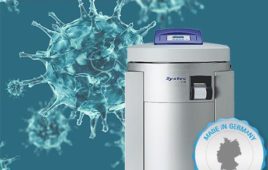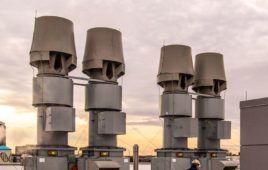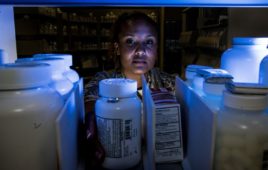For nearly 10 years, the ISO 14644-1 and ISO 14644-2 standards have been reviewed and revised. Recently the members of ISO Technical Committee (ISO/TC) 209 approved the latest revisions to ISO 14644, Cleanrooms and associated controlled environments — Part 1: Classification of air cleanliness and Part 2: Monitoring to provide evidence of cleanroom performance related to air cleanliness by particle concentration. The Convener of ISO/TC 209 WG-1, Gordon Farquharson, drove to get total consensus whenever possible and took every measure to get consensus from all participating countries. The IEST serves as the Secretariat for ANSI for ISO Technical Committee (ISO/TC) 209, which is responsible for cleanrooms standards development. The revised standards will be available for purchase from the IEST in 2016.
For over 22 years, Robert Mielke has been the Secretary for ISO/TC 209. Bob has also been one of the U.S. subject matter experts on ISO/TC 209 WG 1 which has the responsibility for ISO 14644 Parts 1 and 2, both the first time that ISO 14644-1:1999 and ISO 14644-2:2000 was written and for the current revisions. Over the years, he has taught courses for IEST on ISO 14644-1 and ISO 14644-2, both at the IEST Fall Conference and the IEST annual technical meeting (ESTECH). He is an IEST fellow and a Senior Faculty member. With the publication of the revised standards, there is a demand for better training and education for all involved in the $14 billion cleanroom industry. Roberta Burrows, Director of the IEST remarked, “We’ve entered a new era of cleanroom classification and monitoring for customers, suppliers, trainers and regulators.”
Robert Mielke will teach a course detailing the changes to the standards on Feb. 2, 2016 at Superior Laboratory Services Cleanroom Demonstration Facility, 1720 Preston Road, Suite A, Pasadena, Texas 77503.
IEST President-Elect, Wei Sun, explains, “Mielke’s in-depth understanding of the ISO 14644-1 and -2 updates and the rationale behind the ISO/TC Working Group’s revisions was gained from his active participation in the laborious Standards revision process and his encouragement of the group’s extended efforts to reach consensus. This truly makes him the best choice for educating you and your company on the details of the decisions and application of the Part 1 and Part 2 changes.”
For more information and to register for this course, go to www.iest.org.
ISO 14644-1 specifies classes of air cleanliness for the world’s cleanrooms and controlled environments in terms of the numbers of particles expressed as a concentration of air volume. To determine the class, a specified testing method is required which includes selection of sampling locations within the cleanroom. A major focus in revising ISO 14644-1 (1999) was development of a refined statistical approach regarding the selection and number of sampling locations within the cleanroom. This allows for better sampling of the cleanroom where particle counts may vary in a more complex pattern. Another revision in ISO 14644-1 addresses the issues surrounding >5μm particle limits for ISO Class 5 in the sterile products annexes of the EU, PIC/S, and WHO current GMPs (Good Manufacturing Practices). An adaption of the macro particle descriptor is included in the revised standard to accommodate the particle size and harmonize with the above regulations.
Joseph Gecsey Jr., the other U.S. representative on the ISO 14644-1 working group, provided background and additional information and clarification on the absence of a limit value at >5 microns for ISO Class 5:
“There have been a number of comments on the removal of a specific value for the classification limit of the 5 micron (and larger) particle size channel in ISO 5 of ISO 14644-1:2015.
“Within the revision committee, there was lively debate about this issue; comments also appeared in the responses from mirror committees and other groups from countries that voted on the revisions.
“To start with, we need to realize that we are not sampling 100 percent of the air from a cleanroom or clean zone in the classification process, so we cannot have 100 percent confidence in the value of the airborne particle concentration. The ISO 14644-1 standard details a sampling method based on the light-scattering Airborne Particle Counter (LSAPC); the standard provides a high degree of statistical confidence, bounded by the expected levels of particle concentration and the collection efficiency of the instrument. In areas for which the particle concentrations are very low and/or the collection efficiency of the instrument becomes questionable, the intended confidence level of 95 percent cannot be obtained.
“Given that some regulatory agencies — especially in the Life Science industry — have created cleanroom classes that state maximum concentrations at 5 microns, some participants were concerned that the lack of a value in the ISO 14644-1 document would devalue or alter those industry-specific classifications.
“However, it has been well-established that ISO 14644-1 was never intended to be industry-specific; it was only a statistical sampling method to determine with some confidence the typical concentration of a room or zone in which there was a need to control the airborne particulate levels. Underlying this philosophy is the tenet that every industry has the right to establish airborne particle concentration limits that relate to their processes — what is right for Intel will be different from NASA’s needs or those of Pfizer.
R&D 100 AWARD ENTRIES NOW OPEN:
Establish your company as a technology leader! For more than 50 years, the R&D 100 Awards have showcased new products of technological significance. You can join this exclusive community! Learn more.
“Another important aspect of this decision rests on the behavior of ‘large’ airborne particles whose diameters are roughly 1 micron and larger tend not to remain airborne for long. When executed correctly, the ISO 14644-1 standard provides a method that is intended to provide ‘at least 95 percent confidence of the cleanroom or clean zone does not exceed class limits’ (A.4.1). The rapid settling (due to gravity) of particles 5 microns and larger, coupled with reality of poor collection efficiency of airborne particle counters for larger particles creates a situation for which the confidence cannot be assured to be ‘at least 95 percent.’
“In spite of these realities of physics and instrument performance, many comments related to the perceived impact on regulated industries, and in particular, the use of airborne particle counters to provide some indication of the risks of potential microbiological levels when quantities of larger particles are detected. The ISO 14644-1 Scope very carefully and firmly states that the classification method stated is not to be used to establish a classification for other airborne items, such as radioactive, chemical, or viable entities.
‘This part of ISO 14644 cannot be used to characterize the physical, chemical, radiological, and viable of other nature of airborne particles.’ (ISO 14644-1:2015, Part 1, Section 1 (Scope))
“Although it would be desired by several industries, today there is not an effective “industry neutral” global document for classification based on the concentration of airborne viable entities. This goal has proven to be a difficult (some would say “impossible”) effort due to the widely varying needs of various users in the wide range of industries with concern with the level of airborne microbes, combined with significant issues of collection efficiency and limitations of various growth media.
“As a final comment, from the viewpoint of history, it is noteworthy that the U.S. Federal Standard 209E — from which much of the ISO 14644-1 document body was drawn — had no numerical value in the classification limits chart for the class closely equivalent to ISO Class 5: Class 100.” (Gecsey can be reached at [email protected] for more detailed information.)
A major revision to ISO 14644-2 to a document is that it recommends considerations for a monitoring strategy after certification. Hence, the title change from Specifications for testing and monitoring to prove continued compliance to the new title Monitoring to provide evidence of cleanroom performance related to air cleanliness by particle concentration. The requirements of a monitoring plan are detailed in the revised standard including guidance on risk assessment.
The mission of ISO/TC 209 is to develop international standards for cleanrooms and associated controlled environments encompassing standardization of equipment, facilities, and operational methods. The committee defines procedural and operational limits and testing procedures to achieve desired attributes to minimize contamination. IEST also serves as the administrator for the U.S. Technical Advisory Group (US TAG) to ISO/ TC 209. The ISO standards tell you “what” you must do to comply and the IEST recommended practices are industry “best practices” that tell you “how” to comply with the standards. The IEST program of standards and practices was instituted to publish and disseminate up-to-date, reliable, technical information within the cleanroom industry. Both ISO 14644 series of standards and IEST recommended practices are available for purchase at www.iest.org.
During the IEST Fall Conference and IEST annual technical meeting and exposition (ESTECH), several working groups meet to review and revise existing recommended practices and new working groups are formed to write critical recommended practices as the cleanroom industry evolves and innovates. Participating in IEST Working Groups allows you to influence the industry while collaborating with the elite experts. Revisions of several recommended practices will be published in 2016. The recommended practices are:
• IEST-RP-CC003.5, Garment Considerations for Cleanrooms and Other Controlled Environments. This revision will include recommendations for Arc Flash cleanroom garments.
• IEST-RP-CC020.1, Documentation Substrates Used in Cleanrooms and Other Controlled Environments. This document provides information to select the correct cleanroom paper for use in cleanrooms.
• IEST-RP-CC025.1, Evaluation of Swabs Used in Cleanrooms and Other Controlled Environments. This new document provides information to select the correct swab for use in cleanrooms.
The Filtration Handbook will be published Q1 2016. The Filtration Handbook contains the recommended practices:
• IEST-RP-CC001, HEPA and ULPA Filters
• IEST-RP-CC002, Unidirectional Flow Clean-Air Devices
• IEST-RP-CC007, Testing ULPA Filters
• IEST-RP-CC021, Testing HEPA and ULPA Filter Media
• IEST-RP-CC034, HEPA and ULPA Filter Leak Tests
ESTECH is an educational event where industry professionals in contamination control, design, test and evaluation, product reliability, aerospace, and nanotechnology meet to learn and exchange innovative ideas in their areas of expertise.
The ISO 14644-1 and 2 course will be taught by Robert Mielke at ESTECH — the conference is scheduled for May 2-5, 2016 at the Renaissance Hotel in Glendale, Ariz. Courses also offered at ESTECH are Cleanroom Basics for the Life Sciences, ESD, and Particle Mechanics and Cleanroom Design. For more information and to register to attend ESTECH, go to www.iest.org.
The author acknowledges and thanks the individuals quoted in this article and IEST staff for their contributions to this article.
Jan Eudy is a Cleanroom/Contamination Control Consultant as well as a Fellow and Past President, Institute of Environmental Sciences and Technology. She is located in Carolina Beach, N.C. and can be reached at [email protected].
This article appeared in the January/February 2016 issue of Controlled Environments.



